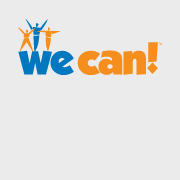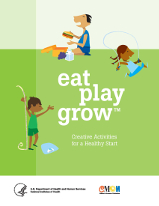Energy Balance
Early Childhood Health Lesson
Objective:
Learn the concept of balancing the amount of energy consumed and the energy used.
We Can! Messages
Engage in 60 min. moderate activity on most, preferably all, days of the week.
Reduce sedentary activity.
Limit screen time to less than 2 hours daily.
Decrease intake of WHOA and SLOW foods.
Increase intake of GO foods.
National Pre-K–2nd Grade Health Performance Standards
Identify that healthy behaviors impact personal health.
Demonstrate healthy practices and behaviors to maintain or improve personal health.
Adult Message
Increase families daily physical activity and intake of GO foods, while reducing screen time and the intake of SLOW and WHOA foods.
Developing Preschool Readiness Skills
Learn body awareness, gross motor development, listening skills, and directionality.
Program Content
Themed lesson plans incorporating art, literacy, movement and music support a multi-disciplinary approach to teaching young children and adults.
Program Length: 70 minutes
Introduction/Discussion
Materials: Name stickers, markers
Welcome families with name stickers and “hello” song. Begin by asking families why everyone
needs to eat. Once families answer that food gives our body nutrients and energy, ask families
what foods they like to eat to get their nutrients and energy. Then ask families to describe how
they use their energy (physical activity movement should be encouraged, but mention that
energy is used throughout the day, even during sleep). Begin to talk about how WHOA foods
have a lot of energy (reminding adults that energy is just another word for calories) and that
when we eat WHOA foods, our body has a lot of energy to use. What happens if we can’t use
all the energy? Our bodies are smart and will store the energy. For adults, explain that this is
how bodies gain weight, storing the extra energy as fat. Children need calories to help them
grow and learn, but they should be eating nutrient-rich foods to gain those calories.
The main communication message is that we should balance the Energy IN (calories we
consume) with the Energy OUT (calories you burn to keep your body going and carry out your
activities). Emphasize that physical activity helps to maintain a healthy weight and is also very
important for building heart, bone, and muscle strength.
Visual References: Chart with GO, SLOW, and WHOA foods as images and chart with text. Chart with images of physical activity options and suggestions.
Key Teaching Messages
- Increase daily GO food/drink intake, while decreasing SLOW and WHOA food/drink intake.
- Increase physical activity.
- Decrease drinking regular soda and juice drinks, while increasing water and fat-free or lowfat milk intake.
Art Activity: Seesaw Collage
To help reinforce the concept of energy balance, children will select images of their favorite physical activities to glue on one side of a seesaw graphic and then select healthy GO foods to place on the other side.
Materials: Seesaw graphic, masking tape, glue, images of physical activities, and GO foods.
Set-up: Tape copy of seesaw graphic at each setting. In the middle of the table, separate piles of physical activities images and GO food images. Have children select images from each pile. Help families discuss how to balance their choices on the seesaw.
Clean-up: Give children a 5 minute warning. Always let children know that you are transitioning and ending the project soon. After the warning, sing a clean-up song to focus children and encourage participation in the clean-up process. One example: “Clean up, clean up one, two, three. I’ll help you and you help me. Clean up, clean up one, two, three. I’ll help you and you help me.”
Physical Activity: Movement/Music
Weekly Structure: Warm-up, Active Play Time, Movement/Music (song/activity), Cool-down. Children should do at least 60 minutes (1 hour) or more of physical activity each day.
Warm-up:
Marching Movement Song
We’re marching, marching, marching
We’re marching in a circle
We’re marching, marching, marching until it’s time to stop!
We’re jumping, jumping, jumping
We’re jumping in a circle,
We’re jumping, jumping, jumping until it’s time to stop!
(add hopping, stomping, running, tiptoeing, etc.)
In and Out Circle Song
Let’s go in and in and in
And out and out and out
And in and in and in and in
And out and out and out!
Active Play Time:
Do 5 or 10 minutes of each exercise
- Playing Tag
- Hopscotch
- Jumping Jacks
- Jumping (one foot, together then apart, front to back)
Movement/Music: Family Balance Challenges
Children will learn balance and develop coordination skills as they play Simon Says and Animal Freeze Dance.
Simon Says: Families will be led through a series of poses and body positions that help highlight balance.
Animal Freeze Dance: When the music plays, families will hop like a bunny, swing like a monkey, tiptoe like a giraffe. When the music stops, families will be asked to hold or balance in their positions.
Cool-down:
It is important for the body to cool down gradually.
- Breathing–Place hands on belly or lower back. Inhale and fill the lungs. Feel the abdomen and ribs inflate. Exhale and empty the lungs. Feel the chest and abdomen relax.
- Yoga Moves
- Downward Dog–Have the children make a bridge with their bodies. From here you can kick one leg up at a time and start to stretch body long.
- Tree Pose–Have the children balance on one leg, bending their other leg at a 90 degree angle, stretching their hands above their heads.
- The Horse–Stand in place for 30 seconds with a wide stance and knees bent (like a halfway down squat position).
Group Storytime
Giraffes Can't Dance by Giles Andrede
From Head to Toe by Eric Carle
Elephants Cannot Dance! by Mo Willems
Healthy Snack
Offer sliced apples with low-fat yogurt and cinnamon dip. An educator-led discussion will give children and adults the opportunity to discuss strategies for incorporating GO food snack choices into their daily diet while increasing their physical activity.
Encourage children to wash hands with soap and warm water before eating snack. Hand
Washing Strategy: Wash hands for 20 seconds to fight off all germs and then rinse well under
running water. Sing the ABC Song while you wash.
Review Family Handout
Goal: Add 10 minutes of physical activity and one GO food every day.
Facts of the Week: Added sugars in foods and drinks provide extra calories, but no additional
nutrients.
At-Home Strategies:
- Eat a low-fat, high-fiber breakfast—it may make you less hungry later in the day.
- Add a few minutes of physical activity whenever you can!
- Decrease intake of WHOA and SLOW.
- Increase intake of GO foods.
- Ask stores to sell more GO foods.
- Set screen time limits for the whole family. More importantly, enforce the rule!
Lesson Visuals
- Energy Balance Seesaw image
- Three pages of low and high energy activity images
- Page of fruit and vegetable images
Lesson: Energy Balance
Early Childhood Health Lesson
Low-Energy
Walking the dog, hopscotching, skateboarding
Moderate-Energy
Playing basketball, playing hula-hoop
High-Energy
Swimming, biking, walking up the stairs, jump roping, playing soccer, ice skating, roller skating
Apples, grapes, pear, peaches, blueberries, bananas, cherries, strawberries, watermelon, oranges.
Family Health Handout
Energy Balance
Benefits of Balancing Energy In (food you eat) with Energy Out (how much you move):
- Helps maintain a healthy weight.
- Allows body to function at its best!
Farmers Market or Green Cart Shopping List
Increase your heart rate
by walking with your family
to your local market and
pick out a healthy snack!
Family Goal
Goal: Add 10 minutes of physical activity and 1 GO food every day.
Monday
Physical Activity added:
GO food added:
Tuesday
Physical Activity added:
GO food added:
Wednesday
Physical Activity added:
GO food added:
Thursday
Physical Activity added:
GO food added:
Friday
Physical Activity added:
GO food added:
Saturday
Physical Activity added:
GO food added:
Sunday
Physical Activity added:
GO food added:
Fact of the Week
Added sugars in foods and drinks provide extra calories, but no additional nutrients.
Strategy
Eat a low-fat, high-fiber breakfast—it may make you less hungry later in the day. Try whole grain cereal with fruit.
Surprising Fact
Physical activity can
help children sleep
better. Encourage
60 minutes of physical
activity daily!
Health Tip
Eat food portions that are no larger than your fist.
At-Home Tools
Books
Giraffes Can't Dance by Giles Andreae
From Head to Toe by Eric Carle
Elephants Cannot Dance! by Mo Willems
New Energy Words to Use
- Move
- Play
- Balance
- Energy
Did you know…
Calories are needed for the body to perform basic functions, like breathing and sleeping. Many more calories are used during physical activities that increase the heart rate.
Activities
Get Moving Together!
Walk faster than you normally do. Challenge family members to speed-walking contests!
Freeze Dance Parties!
Turn on a variety of music and dance. When the music stops, strike a pose and balance.
Balanced Recipes
GO Snack
Spread a teaspoon of fat-free or low-fat cream cheese on a piece of toasted whole grain bread. Place tomato slices on top.
and
Physical Activity
Pack water in a reusable bottle and enjoy a long family walk!
| Back to Table of Contents | Back to Top |
NIH Publication No. 13-7818
April 2013











